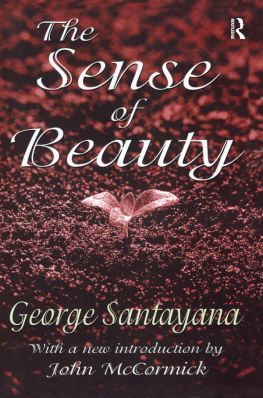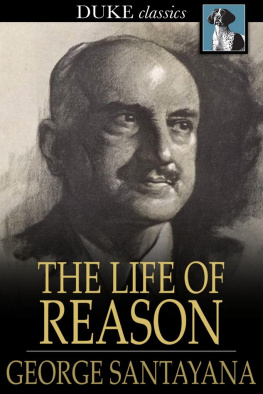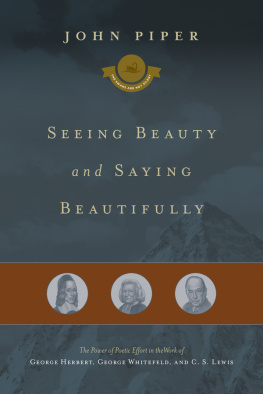George Santayana - The Sense of Beauty
Here you can read online George Santayana - The Sense of Beauty full text of the book (entire story) in english for free. Download pdf and epub, get meaning, cover and reviews about this ebook. year: 2003, publisher: Transaction, genre: Science. Description of the work, (preface) as well as reviews are available. Best literature library LitArk.com created for fans of good reading and offers a wide selection of genres:
Romance novel
Science fiction
Adventure
Detective
Science
History
Home and family
Prose
Art
Politics
Computer
Non-fiction
Religion
Business
Children
Humor
Choose a favorite category and find really read worthwhile books. Enjoy immersion in the world of imagination, feel the emotions of the characters or learn something new for yourself, make an fascinating discovery.
- Book:The Sense of Beauty
- Author:
- Publisher:Transaction
- Genre:
- Year:2003
- Rating:4 / 5
- Favourites:Add to favourites
- Your mark:
- 80
- 1
- 2
- 3
- 4
- 5
The Sense of Beauty: summary, description and annotation
We offer to read an annotation, description, summary or preface (depends on what the author of the book "The Sense of Beauty" wrote himself). If you haven't found the necessary information about the book — write in the comments, we will try to find it.
The Sense of Beauty — read online for free the complete book (whole text) full work
Below is the text of the book, divided by pages. System saving the place of the last page read, allows you to conveniently read the book "The Sense of Beauty" online for free, without having to search again every time where you left off. Put a bookmark, and you can go to the page where you finished reading at any time.
Font size:
Interval:
Bookmark:

Originally published in 1896 by Charles Scribners Sons.
First published 2003 by Transaction Publishers
Published 2019 by Routledge
2 Park Square, Milton Park, Abingdon, Oxon OX14 4RN
52 Vanderbilt Avenue, New York, NY 10017
Routledge is an imprint of the Taylor & Francis Group, an informa business
New material this edition copyright 2003 Taylor & Francis.
All rights reserved. No part of this book may be reprinted or reproduced or utilised in any form or by any electronic, mechanical, or other means, now known or hereafter invented, including photocopying and recording, or in any information storage or retrieval system, without permission in writing from the publishers.
Notice:
Product or corporate names may be trademarks or registered trademarks, and are used only for identification and explanation without intent to infringe.
Library of Congress Catalog Number: 2002032255
Library of Congress Cataloging-in-Publication Data
Santayana, George, 1863-1952.
The sense of beauty / George Santayana ; with a new introduction by John
McCormick.
p. cm.
Originally published: New York : Charles Scribners Sons, 1896. With
new introd.
ISBN 0-7658-0984-2 (alk. paper)
1.Aesthetics.I.Title.
B945.S23 S45 2002
111.85dc21
2002032255
ISBN 13: 978-0-7658-0984-1 (pbk)
To the English speaking reader of the twenty-first century, the very word beauty of Santayanas title is suspect. We may say of a Siamese cat, a glass of wine, or a portrait by Goya, What a beauty, but we shy away from the vague abstraction, foreign to the contemporaiy consciousness, ironic, anti-historical, and deconstructive, in the jargon of the post-modernists. It is essential therefore to recall the ambience in which Santayana wrote. Published in 1896 when Santayana was thirty-three, his book undercut the fin de siecle aestheticism of Walter (bum with a hard gem-like flame) Pater, of Ruskins widely popular but untheoretical discriminations, and of a cult of beauty among the many asexual young men drawn to a mystical conception of religious ritual and its trappings. Those influences were English, but English modes of thought and expression dominated the young men of Harvard whom Santayana taught, as it dominated the minds of the educated and those whom Santayana judged to be well-bred. Spanish by nationality, American by education formally completed by residence in Germany and allegiance to ancient Greek, Latin, Spanish, English, and French modes of thought, Santayana addressed the world rather than a single part of it. His world was distant from ours. It was secure in its beliefs and prejudices, hierarchical in society and confident in its assertions relating to class, breeding, wealth, and duties. Santayanas foreign birth together with his exotic appearance (he was once described as a mango among the Jonathan apples) enforced his congenital scepticism, even as he fitted himself into Harvard and Bostonian circles. Scepticism concerning traditional treatises led him to a theory of aesthetics that continues to be read and debated from his time to ours.
Santayanas motives for writing his treatise were mixed. Authoritative gossip had informed him that his instructorship at Harvard was at risk unless he produced a book. He had published many essays and reviews, as well as Sonnets and Other Verses (1894), but the sages of the department of philosophy wanted a book. Very well, he would oblige. As a graduate student, he had turned to William James to supervise a Ph.D. dissertation on Schopenhauer, but James shifted him over to Josiah Royce, whom Santayana respected but whose metaphysics he could not admire. Royce insisted that the young student write on Rudolf Hermann Lotze (18171881); Santayana did so, to produce Lotzes System of Philosophy which remained unpublished, significantly, until 1971, nineteen years after his death. It is a workmanlike treatise, undoubtedly influenced by Royces heavy hand. The treatise includes a discussion of Lotzes aesthetics, providing a partial base for The Sense of Beauty . A more immediate source was his lecture course in aesthetics for undergraduates. The subject was in his mind and already neatly organized.
That neatness, together with Santayanas economy of expression, accounts for the apparent brevity of the book, but it does not account for a style at once concrete and allusive, precise and expansive. The resulting book is a small package but a full one. One notes in passing that it is also the first aesthetics written in the United States. Santayana well knew the history of his subject, from Plato and Aristotle, to Longinus, to the neo-classical theorists of the seventeenth and eighteenth centuries, and to Schopenhauer and Taine, of the nineteenth. Pre-nineteenth-century aesthetics had taken for granted that beautiful objects were ontological, that beauty resided in the sculpture, the painting, the architecture of Bramante, in the structure and pain of tragedy. Eighteenth-century aestheticians such as Lessing had been especially concerned with classification in the arts, together with an entity called form, more often than not left vague and imprecise; appreciation, not analysis resulted. Schopenhauer bordered on the psychological in allying aesthetics to Will, to the individual, as in an even less exact manner did Taine.
Writing with a consciousness of history but contrary to accepted beliefs, Santayana defined beauty at the very beginning of his book as pleasure objectified. Beauty is a value it is not a perception of a matter of fact or of a relation; it is an emotion, an affection of our volitional and appreciative nature. That value is positive, reflecting the presence of something good, or (in the case of ugliness) of its absence. It is never the perception of a positive evil, it is never a negative value. Aesthetic pleasure is not useful; it is not related to ethics, which by definition emphasizes the correction of wrong, of evil. Aesthetic pleasure lies in the self, it is psychological, it is a Good. His task was to overcome our distrust of the self, of our own feelings. We rely on the principle of objectivity in aesthetic and moral judgment because of self-distrust.
Under three major headings, Materials of Beauty, Form, and Expression, Santayana develops his thought, but he never hectors his opponents or his readers, a quality that annoys teachers of philosophy to this day but earns their grudging respect. Santayana feared and loathed fanaticism in any form. He was neither concerned to attract disciples nor to form a school. In setting forth the psychological aspect of beauty, he defined the many avenues of sense that combine to form ones sense of beauty, thus extending perception to temperament, education, society, and even politics. Previous writers had tended to confine perception to vision, while Santayana also distinguished a transcendental quality in the sense of beauty. His use of the word sense here suggests that in his mind is the Spanish sentido , meaning depth of feeling, sensitivity, the entire consciousness, meanings rarely or never associated with the English sense. Beauty is material, he insists, rooted in concrete reactions of the senses, yet disturbances to the senses such as changes in blood pressure or drowsiness can produce effects favorable to the imagination. It would be curious and surprising to discover how much the pleasure of breathing has to do with our highest and most transcendental ideals. Hisemphasis upon the materiality of beauty must be underlined. The presence of the material is indispensable. Form cannot be the form of nothing. The material is central and inevitable to comprehension of his thought in his outstanding later work. A partial list must include The Life of Reason (19051906, 5 volumes); Character and Opinion in the United States (1920); Scepticism and Animal Faith (1923); Realms of Being (19271938, 4 volumes). In this first book, materialism is muted, but as in the later work too, it is allied to intuition and to the transcendental, ultimately to a Platonic-Santayanaesque Good. Santayana passed decades in expounding what many commentators have seen as a dilemma: materialism joined to a seeming metaphysical conception. He resisted being labelled as a realist, a humanist, or any other ist, while asserting that human beings are animals that happened to develop thumbs and large brains. To his own satisfaction he devised a theory of essences that forms the links between the material (the essential base), the transcendental, and the spiritual. In his late work, beauty is an essence. I suspect that the theory of essences has about it a faint odor of the Roman Catholicism in which Santayana was born. Although he turned away from the church to atheism, he continued to find aesthetic beauty in Catholic ritual and art. To another Catholic atheist, Santayanas essences bear a certain resemblance to the doctrine of grace.
Font size:
Interval:
Bookmark:
Similar books «The Sense of Beauty»
Look at similar books to The Sense of Beauty. We have selected literature similar in name and meaning in the hope of providing readers with more options to find new, interesting, not yet read works.
Discussion, reviews of the book The Sense of Beauty and just readers' own opinions. Leave your comments, write what you think about the work, its meaning or the main characters. Specify what exactly you liked and what you didn't like, and why you think so.





![Santayana - The life of reason, [or], the phases of human progress](/uploads/posts/book/233706/thumbs/santayana-the-life-of-reason-or-the-phases-of.jpg)


